Warehouse safety is a critical concern for businesses across the globe. With warehouses playing a pivotal role in the supply chain, ensuring the safety of the workforce in these environments is not just a regulatory requirement but a moral obligation. As the backbone of distribution networks, warehouses are bustling hubs of activity where goods are received, stored, and dispatched. However, this dynamic environment also presents a myriad of potential hazards, from heavy machinery and high stacking shelves to hazardous materials and constant human movement.
In recent years, the landscape of warehouse operations has undergone significant changes, driven largely by the rise of e-commerce and evolving industry practices. These changes, while beneficial in streamlining operations and meeting consumer demand, have also introduced new risks and exacerbated existing ones. The increasing pace of work, the integration of advanced technologies, and the reliance on temporary or undertrained staff have all contributed to a more hazardous work environment. As a result, the importance of robust warehouse safety protocols has never been more paramount.
Understanding and addressing these risks is crucial for any business looking to protect its employees, reduce the likelihood of accidents, and maintain operational efficiency. In this article, we will explore the key challenges facing warehouse safety today and offer practical solutions to mitigate these risks.
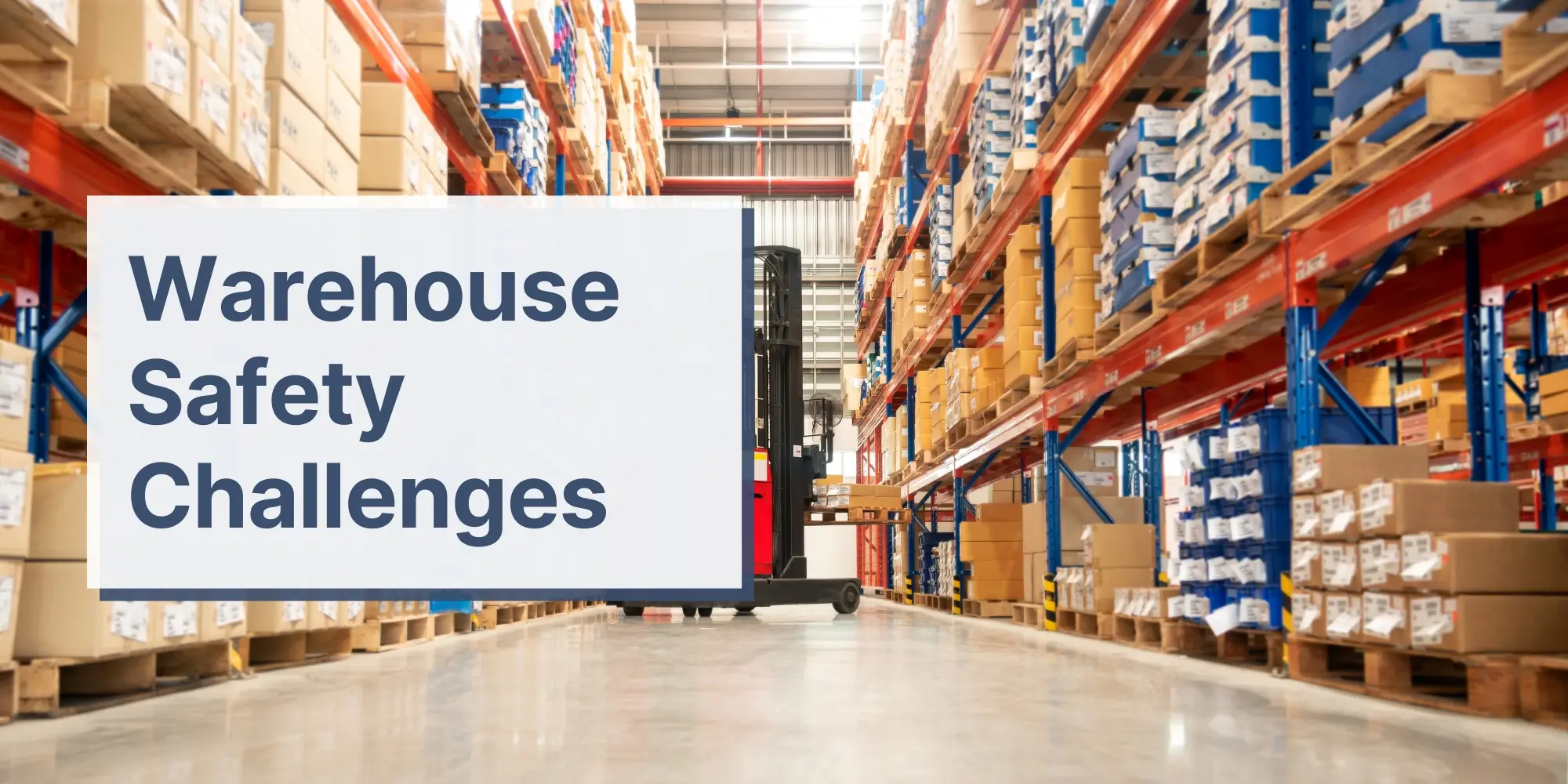
Today’s Warehouse Safety Challenges
The modern warehouse faces a range of safety challenges that have evolved alongside changes in industry practices. Among the most significant of these challenges are the effects of a low unemployment rate, a shortage of skilled talent, the rapid growth of e-commerce, and the ever-changing nature of workflow and workload demands. Each of these factors contributes to a complex and often hazardous working environment, where the risk of accidents is heightened.
Low Unemployment Rate and Talent Shortage
A low unemployment rate, while beneficial for the economy, poses a unique challenge for warehouse safety. With fewer people available for work, businesses often struggle to find adequately trained and experienced staff to fill critical warehouse positions. This talent shortage means that many warehouses are forced to rely on less experienced workers, who may not be fully versed in safety protocols or the proper handling of equipment. This lack of experience increases the likelihood of accidents, as untrained workers are more prone to making mistakes that can lead to injuries.
The E-Commerce Boom
The explosion of e-commerce has revolutionized the way goods are bought and sold, but it has also placed unprecedented pressure on warehouses. The need for rapid order fulfillment and quick turnaround times has led to a significant increase in workload for warehouse staff. In many cases, this has resulted in a faster pace of work, with employees required to pick, pack, and ship orders at breakneck speeds. The physical demands of this accelerated workflow can lead to fatigue, which is a major contributing factor to workplace accidents. Additionally, the high volume of goods being processed can lead to overcrowded storage areas, increasing the risk of trips, falls, and collisions.
Constant Workflow and Workload Changes
The dynamic nature of warehouse operations means that workloads can fluctuate drastically, often with little warning. Seasonal peaks, promotional events, and supply chain disruptions can all lead to sudden increases in the volume of goods that need to be handled. This constant change in workflow requires a flexible and adaptive workforce, but it also introduces new safety risks. Workers may be required to quickly adapt to new tasks, equipment, or processes, sometimes without adequate training or preparation. This can result in improper handling techniques, the misuse of equipment, and ultimately, a higher incidence of accidents.
Rising Rates of Warehouse Injuries and Fatalities
The combination of these challenges has led to a worrying trend: an increase in warehouse injuries and fatalities. According to recent statistics, the injury rate in warehouse settings has reached 5.1 per 100 full-time workers, a figure that mirrors the injury rates found in high-risk industries like farming. In 2015, 11 warehouse workers lost their lives due to job-related injuries, and this number rose to 22 by 2017. These statistics highlight the urgent need for improved safety measures in warehouses to protect workers from the growing risks associated with this demanding industry.
As warehouses continue to evolve to meet the demands of the modern market, addressing these safety challenges is critical. By understanding the factors that contribute to these risks, businesses can take proactive steps to safeguard their workforce and ensure a safer, more productive working environment.
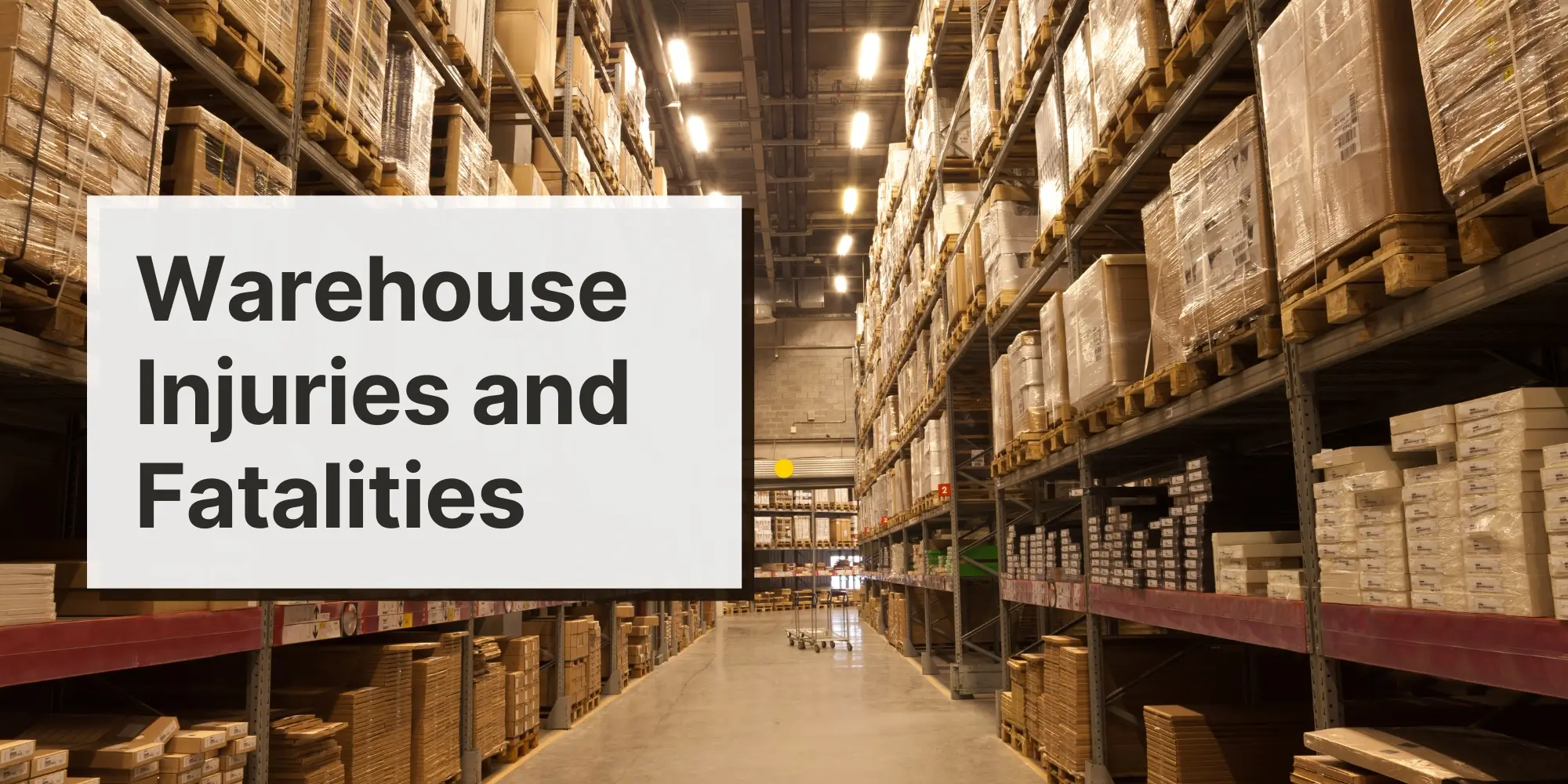
Warehouse Injuries and Fatalities
Warehouse safety is a growing concern as the number of injuries and fatalities in these environments continues to climb. The statistics reveal a troubling trend that underscores the need for immediate attention and action.
Rising Statistics on Injuries and Fatalities
The U.S. Bureau of Labor Statistics reports that the injury rate in warehouse settings has remained high, with 5.1 injuries per 100 full-time workers. This rate is comparable to high-risk industries such as agriculture, known for its hazardous conditions. The following data highlights the severity of the issue:
- 2015: 11 warehouse workers lost their lives due to job-related injuries.
- 2016: The number of fatalities increased to 16.
- 2017: The trend worsened, with 22 fatalities recorded.
These numbers not only represent a loss of life but also reflect the ongoing risks that warehouse workers face daily.
The Toll of Non-Fatal Injuries
Beyond fatalities, non-fatal injuries are also alarmingly common in warehouses. These injuries vary in severity, ranging from minor cuts and bruises to more serious incidents like fractures, amputations, and musculoskeletal disorders. The physical demands of warehouse work, such as lifting, bending, and reaching, contribute significantly to these injuries. Repetitive strain injuries, in particular, are widespread, often leading to chronic pain and long-term disability.
The Impact of Talent Shortage on Safety
The talent shortage in the warehouse industry is a critical factor exacerbating safety issues. With a limited pool of experienced workers, many warehouses are forced to hire less skilled employees who may lack the necessary training in safety protocols. This lack of experience increases the likelihood of accidents, as untrained workers are more prone to making errors, mishandling equipment, and failing to recognize potential hazards.
Moreover, the rush to fill positions often results in minimal training for new hires, placing them at greater risk of injury. The combination of inexperienced workers and the physically demanding nature of warehouse tasks creates a perfect storm for accidents to occur.
The Broader Implications
The consequences of these accidents extend beyond physical harm. For businesses, the financial costs associated with workplace injuries can be substantial, including medical expenses, workers’ compensation claims, and potential legal fees. Additionally, the loss of skilled workers due to injury can lead to decreased productivity, increased turnover, and a decline in employee morale.
In summary, the rising rates of injuries and fatalities in warehouses highlight an urgent need for enhanced safety measures and better training for workers. Addressing the talent shortage and equipping all employees with the necessary knowledge and skills are crucial steps in reducing accidents and safeguarding the well-being of the warehouse workforce.
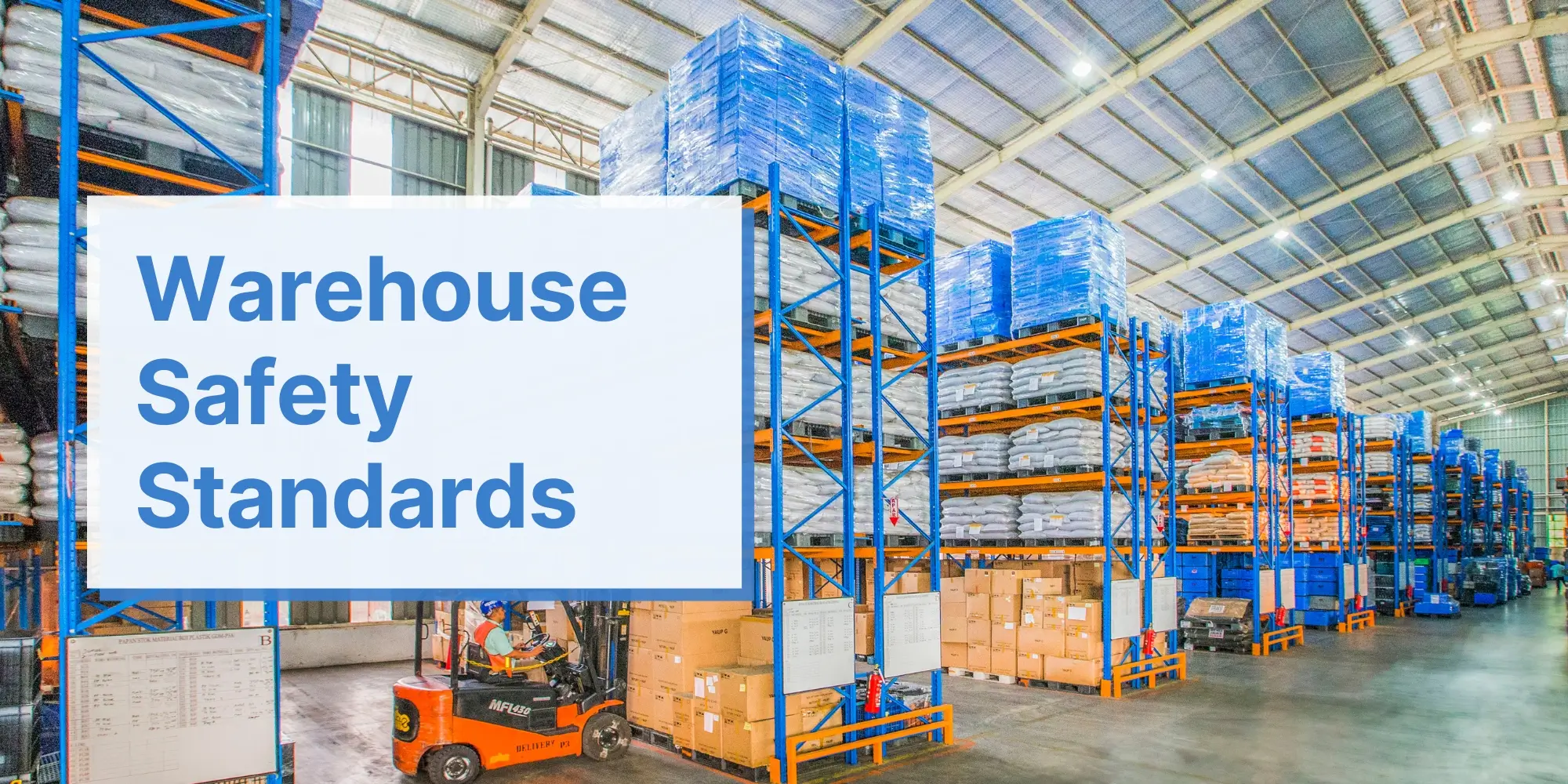
Warehouse Safety Standards
Maintaining a safe working environment in warehouses is essential for the well-being of employees and the overall efficiency of operations. To achieve this, adherence to established safety standards is crucial. These standards are designed to mitigate risks, prevent accidents, and ensure that workers can perform their tasks in a secure environment.
General Industry Standards for Warehouse Safety
Warehouse safety is governed by a set of general industry standards that apply across various sectors. These standards address a wide range of potential hazards commonly found in warehouse environments. Key areas covered by these standards include:
- Forklift Operation: Ensuring that forklifts are operated safely, with proper training for operators, routine maintenance of equipment, and adherence to load limits.
- Hazard Communication: Mandating the proper labeling of hazardous materials, the provision of Material Safety Data Sheets (MSDS), and comprehensive training for employees on handling these substances safely.
- Electrical Safety: Establishing protocols for safe wiring methods, system design, and maintenance to prevent electrical hazards.
- Guarding Floor and Wall Openings: Requiring protective measures to prevent falls from elevated surfaces or through floor and wall openings.
- Exits and Emergency Exits: Ensuring that all exits are clearly marked, accessible, and free from obstructions, with proper evacuation procedures in place.
- Mechanical Power Transmission: Implementing safeguards to protect workers from injuries related to moving parts of machinery.
- Respiratory Protection: Providing appropriate respiratory equipment when workers are exposed to harmful airborne substances.
- Lockout/Tagout (LOTO): Procedures to ensure that machinery is properly shut off and cannot be started again before maintenance or repair work is completed.
- Portable Fire Extinguishers: Ensuring that fire extinguishers are readily available, properly maintained, and that employees are trained in their use.
These standards are designed to cover the most common risks in warehouse environments, providing a framework that employers must follow to create a safe workplace.
OSHA’s Role in Enforcing Warehouse Safety Standards
The Occupational Safety and Health Administration (OSHA) plays a pivotal role in enforcing warehouse safety standards. As the federal agency responsible for ensuring safe and healthy working conditions, OSHA sets and enforces standards through a combination of regulations, inspections, and penalties.
OSHA’s enforcement efforts include:
- Regular Inspections: OSHA conducts inspections of warehouse facilities to ensure compliance with safety standards. These inspections may be random or triggered by reports of unsafe conditions, accidents, or fatalities.
- Citations and Penalties: If a warehouse is found to be in violation of OSHA standards, the agency can issue citations and impose fines. These penalties can be significant, particularly if the violations are severe or repeated.
- Guidance and Resources: OSHA provides a wealth of resources to help employers understand and comply with safety standards. This includes training materials, guidelines, and publications such as the “Worker Safety Series: Warehousing,” which offers practical advice on reducing common hazards.
- Training Requirements: OSHA mandates that warehouse employers provide ongoing safety training to their employees. This training must cover the specific hazards present in the workplace and ensure that workers are knowledgeable about the safety protocols they need to follow.
By setting these standards and enforcing compliance, OSHA ensures that warehouse environments remain as safe as possible for workers. Employers who adhere to these guidelines not only protect their employees but also reduce the risk of costly accidents, legal liabilities, and disruptions to their operations.
In conclusion, adherence to warehouse safety standards is essential for creating a secure work environment. OSHA’s role in setting and enforcing these standards is critical in helping employers maintain compliance and protect their workforce from harm.
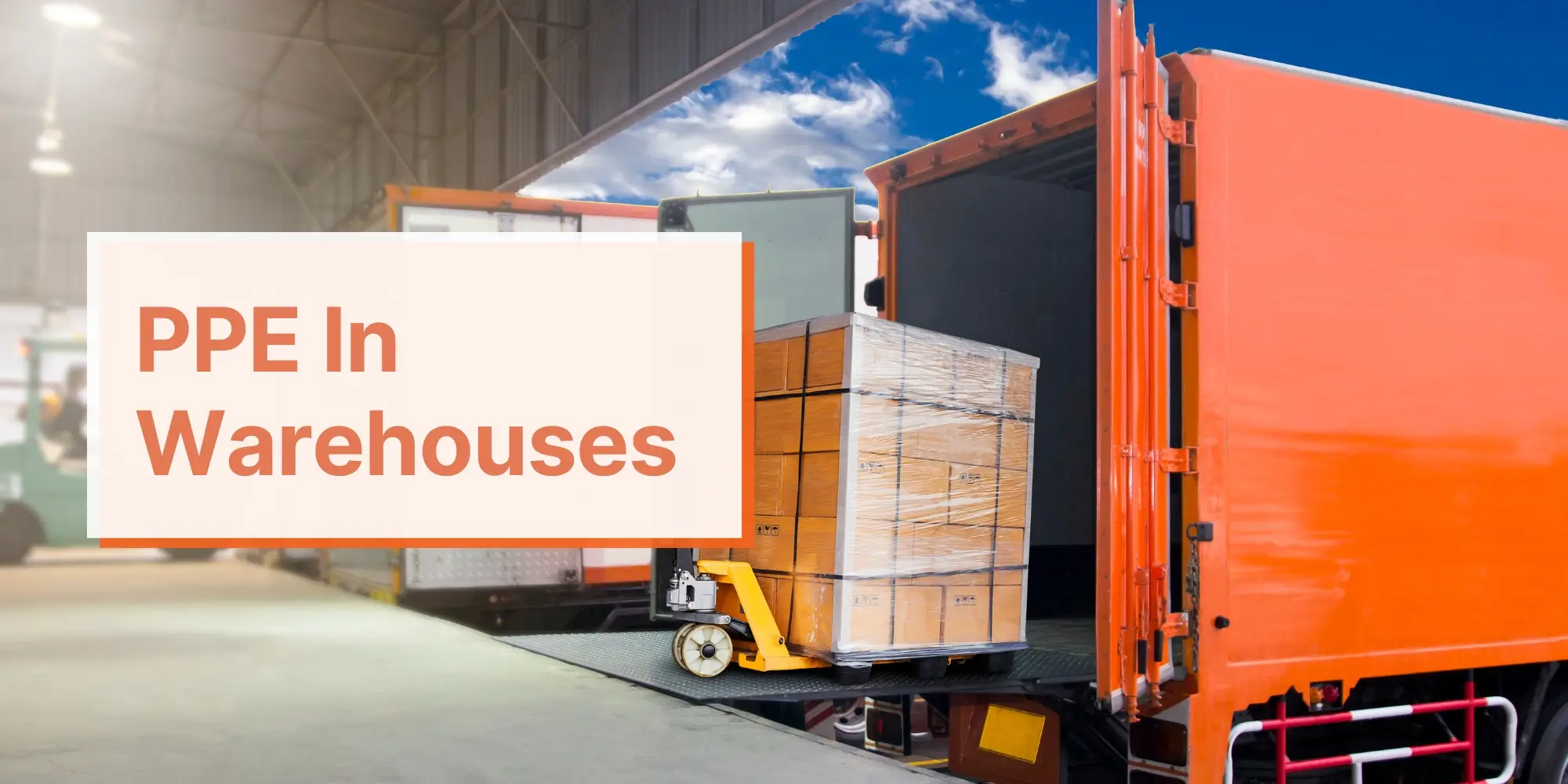
PPE (Personal Protective Equipment) in Warehouses
Personal Protective Equipment (PPE) is a crucial component of safety in warehouse environments. PPE serves as the last line of defense against injuries and accidents, protecting workers from a variety of hazards they may encounter during their daily tasks. Ensuring that the right PPE is available and properly used is essential for maintaining a safe working environment.
Types of PPE Required in Warehouse Settings
Warehouses present a range of potential hazards, each requiring specific types of PPE to mitigate risks effectively. The following are some of the most commonly required PPE in warehouse settings:
- Hard Hats: Essential for protecting against head injuries from falling objects, bumps, or impacts with overhead structures.
- Safety Glasses or Goggles: These protect the eyes from dust, flying debris, and chemical splashes. In some cases, full-face shields may be necessary for more hazardous tasks.
- High-Visibility Clothing: Reflective vests or jackets ensure that workers are easily seen, particularly in areas with moving vehicles like forklifts.
- Safety Boots with Steel Toe Caps: These provide crucial protection against foot injuries from heavy objects or vehicles running over feet. Steel midsole boots are also used to protect against punctures from sharp objects on the floor.
- Gloves: Different types of gloves are used depending on the task, such as cut-resistant gloves for handling sharp objects, thermal gloves for cold storage, and chemical-resistant gloves for handling hazardous substances.
- Respirators or Masks: In environments where workers are exposed to dust, fumes, or other airborne contaminants, respirators or masks are essential to protect respiratory health.
- Hearing Protection: Earplugs or earmuffs may be required in areas with high noise levels to prevent hearing damage.
Each type of PPE is designed to address specific risks within the warehouse, ensuring that workers are protected from the dangers inherent in their work environment.
Employer Responsibilities for PPE
Employers play a critical role in ensuring that PPE is both available and effective. Their responsibilities include:
- Hazard Assessment: Employers must conduct regular hazard assessments to determine the specific types of PPE required in different areas of the warehouse.
- Provision of PPE: It is the employer’s responsibility to provide all necessary PPE to workers at no cost. This includes ensuring that the PPE meets the relevant safety standards and is appropriate for the specific hazards present.
- Training: Employers must train workers on the correct use, care, and maintenance of PPE. This training should cover when PPE is necessary, how to properly wear and adjust it, the limitations of the equipment, and the proper procedures for maintenance and disposal.
- Maintenance and Replacement: Employers are also responsible for maintaining PPE in good working condition. This includes regular inspections, cleaning, and timely replacement of worn or damaged equipment.
- Enforcement: Employers must enforce the use of PPE, ensuring that all employees comply with the safety requirements and wear the appropriate equipment at all times.
Employee Responsibilities for PPE
While employers have significant responsibilities in providing PPE, employees also have critical roles in ensuring their own safety:
- Proper Use: Employees must use PPE correctly according to the training provided. This includes wearing the equipment properly and ensuring it fits securely.
- Maintenance: Workers are responsible for taking care of their PPE, which includes cleaning it regularly, storing it properly when not in use, and inspecting it for any damage before use.
- Reporting Issues: If PPE is damaged, doesn’t fit properly, or is no longer effective, employees must report these issues to their supervisors immediately. Prompt reporting ensures that necessary repairs or replacements can be made to maintain safety.
- Compliance: Employees must comply with all PPE requirements set by the employer. Failure to do so not only puts the individual at risk but can also endanger colleagues and violate workplace safety regulations.
In summary, Personal Protective Equipment is a vital part of ensuring safety in warehouse settings. Employers must provide, maintain, and enforce the use of PPE, while employees must take responsibility for proper use and care. Together, these efforts help create a safer work environment, reducing the risk of accidents and injuries.
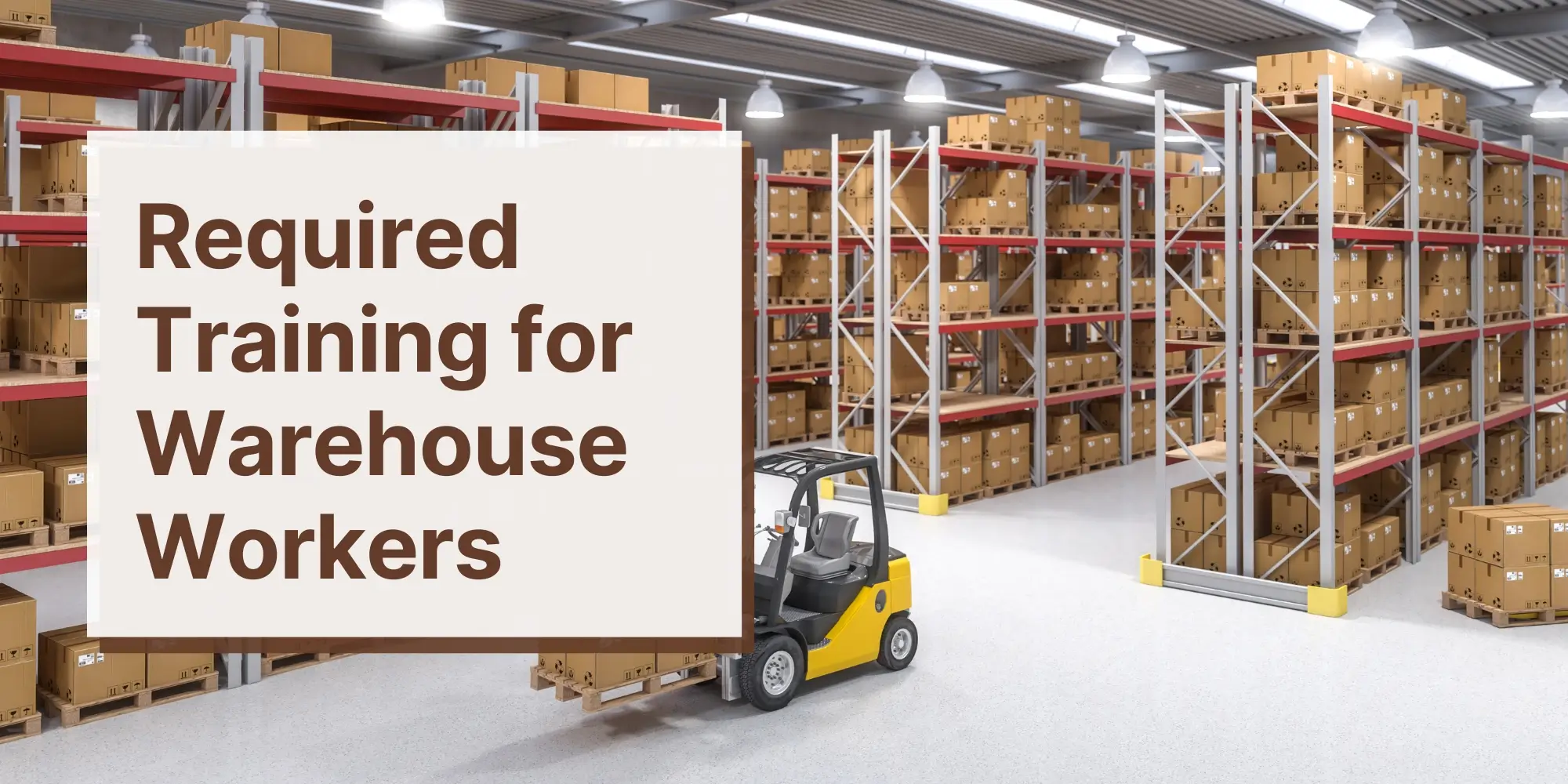
Required Training for Warehouse Workers
Training is a cornerstone of safety in any workplace, and in a warehouse setting, it becomes even more critical due to the variety of hazards workers face daily. Continuous training programs are essential for equipping employees with the knowledge and skills they need to perform their tasks safely and effectively. Proper training helps prevent accidents, reduces the severity of injuries, and ensures that all workers are aware of the best practices for maintaining a safe working environment.
The Necessity of Continuous Training Programs
The dynamic nature of warehouse operations means that training cannot be a one-time event. Continuous training is necessary for several reasons:
- Adaptation to New Hazards: As warehouse operations evolve, new equipment, processes, and technologies are introduced. Workers need ongoing training to stay updated on how to safely operate new machinery, handle new materials, and follow updated safety procedures.
- Reinforcement of Safety Practices: Regular training sessions reinforce the importance of safety practices, ensuring that workers do not become complacent or forgetful about essential safety protocols. This reinforcement helps maintain a culture of safety where every worker remains vigilant.
- Onboarding New Employees: With the high turnover rates often seen in warehouse environments, new employees are regularly brought into the workforce. Continuous training ensures that new hires are quickly brought up to speed on safety standards, reducing the likelihood of accidents due to inexperience.
- Regulatory Compliance: Ongoing training helps employers remain compliant with Occupational Safety and Health Administration (OSHA) regulations. OSHA requires that workers receive training specific to the hazards they may encounter in their workplace, and this training must be updated as necessary to address any changes in operations or regulations.
Resources Available Through OSHA for Training
OSHA provides a wealth of resources to assist employers in developing and implementing effective training programs. These resources are designed to help identify workplace hazards, educate workers on how to avoid them, and ensure that employers meet their regulatory obligations.
- OSHA’s Training Requirements in OSHA Standards: This comprehensive booklet outlines the specific training requirements for various industries, including warehousing. It details the types of training that must be provided and offers guidance on how to deliver this training effectively. Employers can use this resource to ensure that their training programs meet OSHA’s standards.
- Hazard Identification Training Tool: OSHA’s Hazard Identification Training Tool is an interactive resource that helps employers and workers identify potential hazards in their workplace. The tool provides scenarios based on real-world situations, allowing users to practice recognizing and addressing hazards before they cause harm. This resource is particularly valuable for training workers to spot risks in dynamic and fast-paced environments like warehouses.
- OSHA Outreach Training Program: OSHA’s Outreach Training Program offers training for workers and employers on the recognition, avoidance, abatement, and prevention of safety and health hazards in workplaces. The program includes 10-hour and 30-hour courses that provide in-depth training on specific workplace hazards and safety standards.
- OSHA Education Centers: OSHA-authorized OTI Education Centers offer training courses that cover various aspects of occupational safety and health. These centers provide opportunities for more advanced training on topics such as hazard communication, forklift safety, and emergency response. The courses offered at these centers can be tailored to meet the specific needs of warehouse environments.
- Online Resources and Publications: OSHA’s website hosts a range of free online resources, including safety guides, fact sheets, posters, and newsletters. These materials can supplement in-person training sessions and serve as handy references for workers and employers alike.
The Importance of Training for a Safe Workplace
Training is not just about meeting regulatory requirements; it is about fostering a culture of safety where every worker is equipped to protect themselves and their colleagues. Continuous training ensures that safety remains a top priority and that all employees are prepared to handle the challenges of working in a warehouse environment. By utilizing the resources provided by OSHA and committing to regular, comprehensive training programs, employers can significantly reduce the risk of accidents and create a safer, more productive workplace.
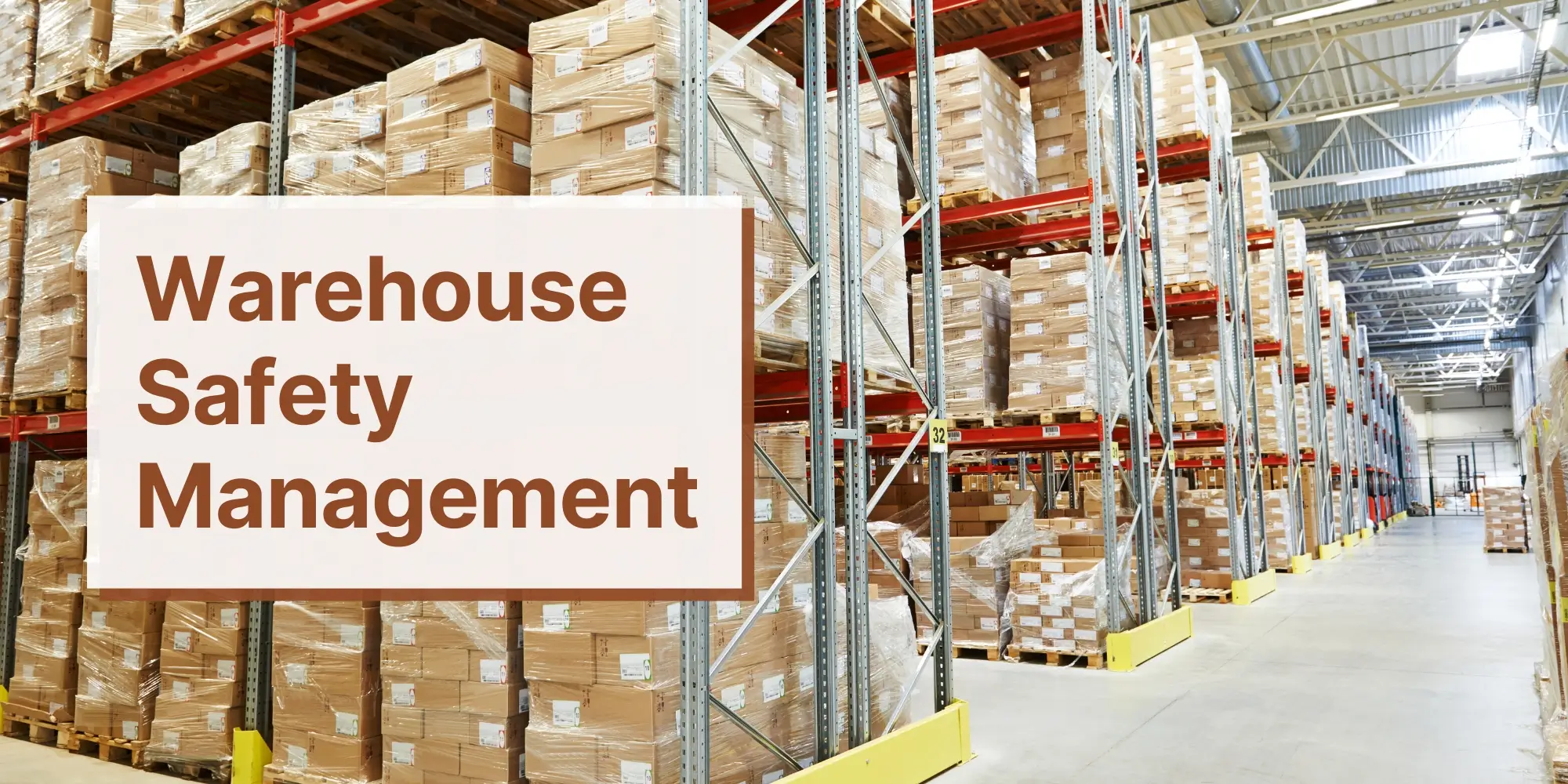
Warehouse Safety Management
Effective safety management is the backbone of any successful warehouse operation. A well-structured safety management plan not only protects the well-being of employees but also enhances operational efficiency, reduces downtime caused by accidents, and ensures compliance with regulatory standards. For warehouses, where the risks of accidents and injuries are significant, having a robust safety management strategy is essential.
Importance of a Solid Safety Management Plan
A solid safety management plan serves as a comprehensive roadmap for identifying, assessing, and mitigating risks in the warehouse environment. The key benefits of a strong safety management plan include:
- Risk Reduction: By systematically identifying potential hazards and implementing preventive measures, a safety management plan significantly reduces the likelihood of accidents and injuries.
- Regulatory Compliance: Adhering to OSHA regulations and other safety standards is crucial for avoiding costly fines and legal liabilities. A well-designed safety plan ensures that all safety protocols are in line with current regulations.
- Employee Morale and Retention: A safe workplace fosters a positive work culture where employees feel valued and protected. This, in turn, leads to higher job satisfaction, lower turnover rates, and increased productivity.
- Cost Savings: Reducing workplace accidents through effective safety management can lead to substantial cost savings in terms of workers’ compensation, medical expenses, and lost productivity.
How to Effectively Train Employees in Warehouse Safety
Training is a critical component of any safety management plan. To effectively train employees in warehouse safety, consider the following steps:
- Develop Comprehensive Training Programs: Create training modules that cover all aspects of warehouse safety, from general safety protocols to specific procedures for operating equipment, handling hazardous materials, and responding to emergencies.
- Utilize a Blended Learning Approach: Combine different training methods, such as classroom instruction, hands-on demonstrations, e-learning, and interactive simulations, to cater to various learning styles and reinforce key concepts.
- Language and Literacy Considerations: Ensure that training is accessible to all employees, regardless of their primary language or literacy level. Providing materials in multiple languages and using visual aids can help bridge communication gaps.
- Conduct Regular Refresher Courses: Safety training should not be a one-time event. Regular refresher courses are essential for reinforcing safety practices and keeping employees up-to-date with any changes in procedures or regulations.
- Incorporate Real-Life Scenarios: Use real-life scenarios and examples relevant to your specific warehouse environment to make training more engaging and practical. This approach helps employees understand how safety principles apply to their daily tasks.
Recommended Safety Meeting Topics
Regular safety meetings are vital for keeping safety top-of-mind and addressing any emerging risks or concerns. Some recommended topics for these meetings include:
- Personal Protective Equipment (PPE): Review the proper use, care, and maintenance of PPE, and discuss any updates or changes to PPE requirements.
- Forklift and Equipment Safety: Reinforce safe operating procedures for forklifts and other machinery, and address any recent incidents or near-misses.
- Emergency Response: Review evacuation plans, fire safety protocols, and procedures for handling medical emergencies.
- Hazard Communication: Ensure that all employees are familiar with the types of hazardous materials in the warehouse, the risks associated with them, and the appropriate safety measures to take.
- Ergonomics: Discuss proper lifting techniques, posture, and strategies to reduce strain and prevent musculoskeletal injuries.
- Workplace Housekeeping: Emphasize the importance of maintaining a clean and organized workspace to prevent slips, trips, and falls.
The Role of Regular Safety Audits and Inspections
Regular safety audits and inspections are crucial for maintaining a safe warehouse environment. These activities help identify potential hazards, assess the effectiveness of current safety measures, and ensure compliance with safety standards.
- Conduct Routine Inspections: Schedule daily, weekly, and monthly inspections to identify and address hazards before they result in accidents. Inspections should cover all areas of the warehouse, including storage zones, loading docks, and equipment.
- Perform Comprehensive Safety Audits: At least once a year, conduct a thorough audit of your entire safety management plan. This audit should evaluate the effectiveness of training programs, safety procedures, and emergency response plans.
- Engage Employees in the Process: Involve employees in safety audits and inspections. Their firsthand knowledge of day-to-day operations can provide valuable insights into potential risks and areas for improvement.
- Act on Findings Promptly: Address any issues identified during audits and inspections as quickly as possible. Implement corrective actions, update safety protocols, and communicate any changes to all employees.
In conclusion, effective warehouse safety management requires a proactive approach that combines comprehensive training, regular safety meetings, and continuous monitoring through audits and inspections. By prioritizing safety and embedding it into the fabric of your warehouse operations, you can create a safer, more efficient workplace where employees are protected, and business thrives.
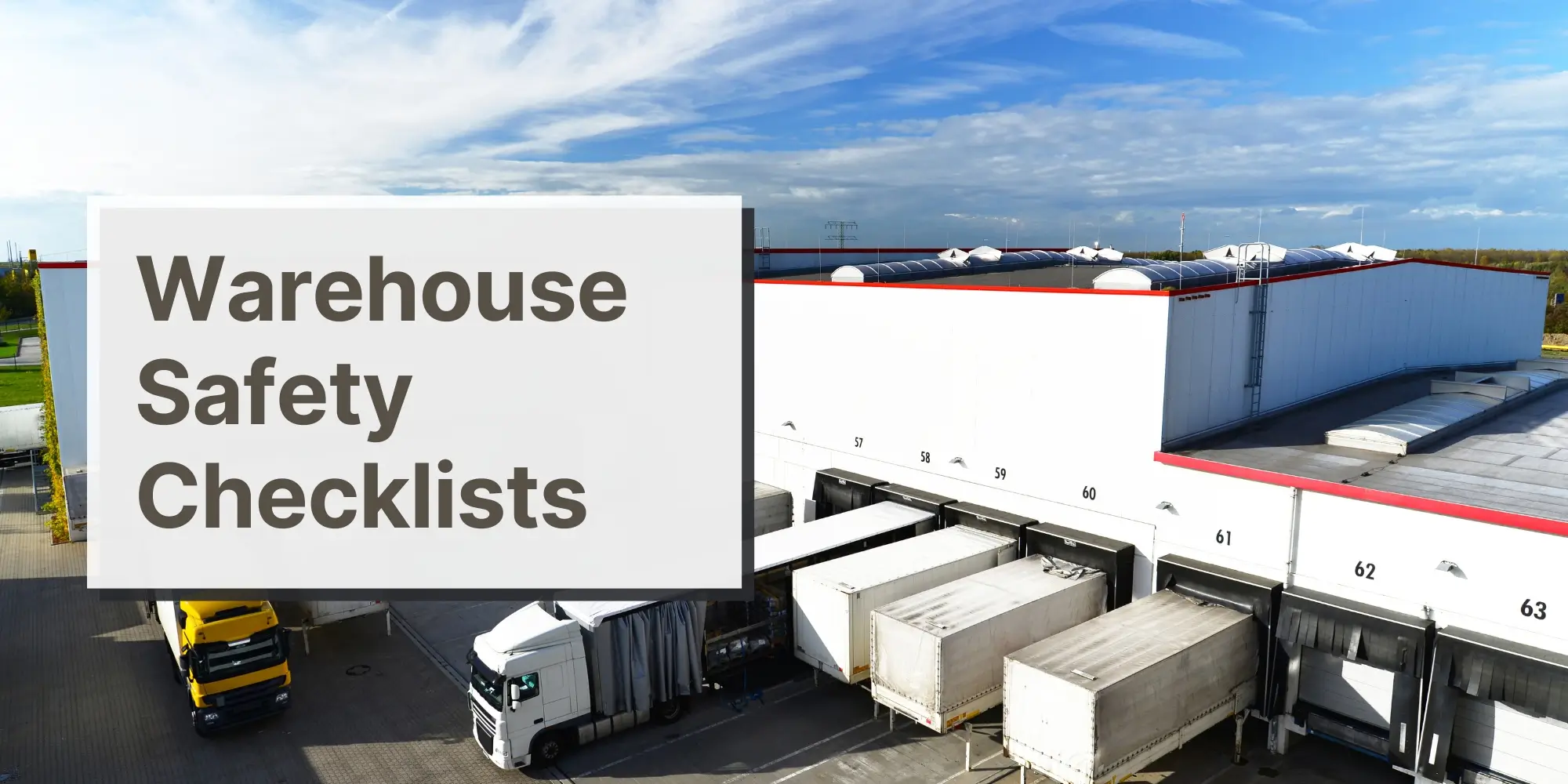
Warehouse Safety Checklists
Checklists are a fundamental tool in maintaining and enforcing safety standards within a warehouse. They provide a structured approach to safety management, ensuring that all critical aspects of warehouse operations are regularly reviewed and that potential hazards are promptly addressed. The use of checklists helps create a culture of accountability and consistency, which is vital for preventing accidents and maintaining a safe working environment.
Importance of Checklists in Maintaining Safety Standards
Checklists serve multiple purposes in warehouse safety management:
- Consistency and Compliance: Checklists ensure that safety inspections and procedures are carried out consistently. By following a standardized checklist, employees can systematically review each aspect of their work environment, ensuring that no safety measure is overlooked.
- Accountability: Checklists create a record of safety checks and inspections, making it easier to track compliance and identify any gaps in safety practices. This documentation can be crucial for internal audits and regulatory inspections.
- Proactive Hazard Identification: Regular use of safety checklists helps in identifying potential hazards before they result in accidents. By routinely checking equipment, work areas, and safety protocols, employees can catch issues early and take corrective action.
- Training and Orientation: Checklists are valuable training tools, especially for new employees. They provide a clear outline of safety expectations and procedures, helping new workers understand their responsibilities and the safety standards they must adhere to.
- Efficiency: Using checklists streamlines the safety inspection process, making it easier and faster to perform thorough checks without missing any critical steps. This efficiency is particularly important in busy warehouse environments where time is a valuable resource.
Examples of Essential Warehouse Safety Checklists
Various checklists can be tailored to the specific needs of a warehouse, addressing different areas and equipment to ensure comprehensive safety coverage. Here are some examples of essential warehouse safety checklists:
Forklift Safety Checklist:
- Pre-Operation Checks: Inspect tires for wear and proper inflation, check fluid levels (oil, coolant, brake fluid), and ensure that all lights, horns, and alarms are functioning.
- Operational Safety: Verify that seatbelts are used, loads are balanced and within the forklift’s capacity, and that the forklift is operated at safe speeds, especially around corners and in congested areas.
- Maintenance Checks: Ensure regular maintenance schedules are followed, including lubrication, battery checks, and inspection of hydraulic systems.
Ergonomics Checklist:
- Lifting Techniques: Ensure that employees use proper lifting techniques, such as bending at the knees, keeping the back straight, and holding loads close to the body.
- Workstation Setup: Check that workstations are set at appropriate heights to reduce strain, with tools and materials within easy reach to minimize unnecessary movements.
- Breaks and Rotation: Verify that employees are taking regular breaks to reduce fatigue and that tasks are rotated to avoid repetitive strain injuries.
General Warehouse Safety Checklist:
- Housekeeping: Ensure that aisles, walkways, and exits are clear of obstructions, and that floors are clean and free of spills or debris that could cause slips or falls.
- Emergency Exits: Check that all emergency exits are clearly marked, unobstructed, and accessible, with proper signage in place.
- Fire Safety: Confirm that fire extinguishers are in place, accessible, and have been inspected regularly, and that employees are trained in fire emergency procedures.
Hazardous Materials Checklist:
- Labeling and Storage: Ensure all hazardous materials are properly labeled according to OSHA standards and stored in appropriate containers in designated areas.
- Spill Response: Verify that spill kits are available and that employees are trained in the proper procedures for cleaning up hazardous spills.
- PPE Usage: Check that employees handling hazardous materials are using the required personal protective equipment, such as gloves, goggles, and respirators.
Equipment Inspection Checklist:
- Tool and Equipment Condition: Inspect tools and equipment for any signs of wear, damage, or malfunction. Remove defective equipment from service until repairs are made.
- Safety Guards and Devices: Ensure that all safety guards, shields, and emergency stop buttons are in place and functional.
Implementing and Using Checklists Effectively
To maximize the benefits of checklists in your warehouse:
- Regular Updates: Keep your checklists up-to-date with the latest safety regulations and best practices. Review them periodically to ensure they cover all relevant aspects of your warehouse operations.
- Employee Involvement: Involve employees in the development and refinement of checklists. Their firsthand experience can help identify areas that need attention and improve the effectiveness of the checklists.
- Accessibility: Make checklists easily accessible to all employees, either in print or digital format. Encourage their use as part of daily routines.
- Follow-Up: Ensure that any issues identified through checklist inspections are addressed promptly. Assign responsibility for corrective actions and track their completion.
In conclusion, checklists are a powerful tool in maintaining high safety standards in a warehouse. By incorporating them into daily operations, warehouses can systematically reduce risks, ensure compliance, and foster a safer, more productive working environment.
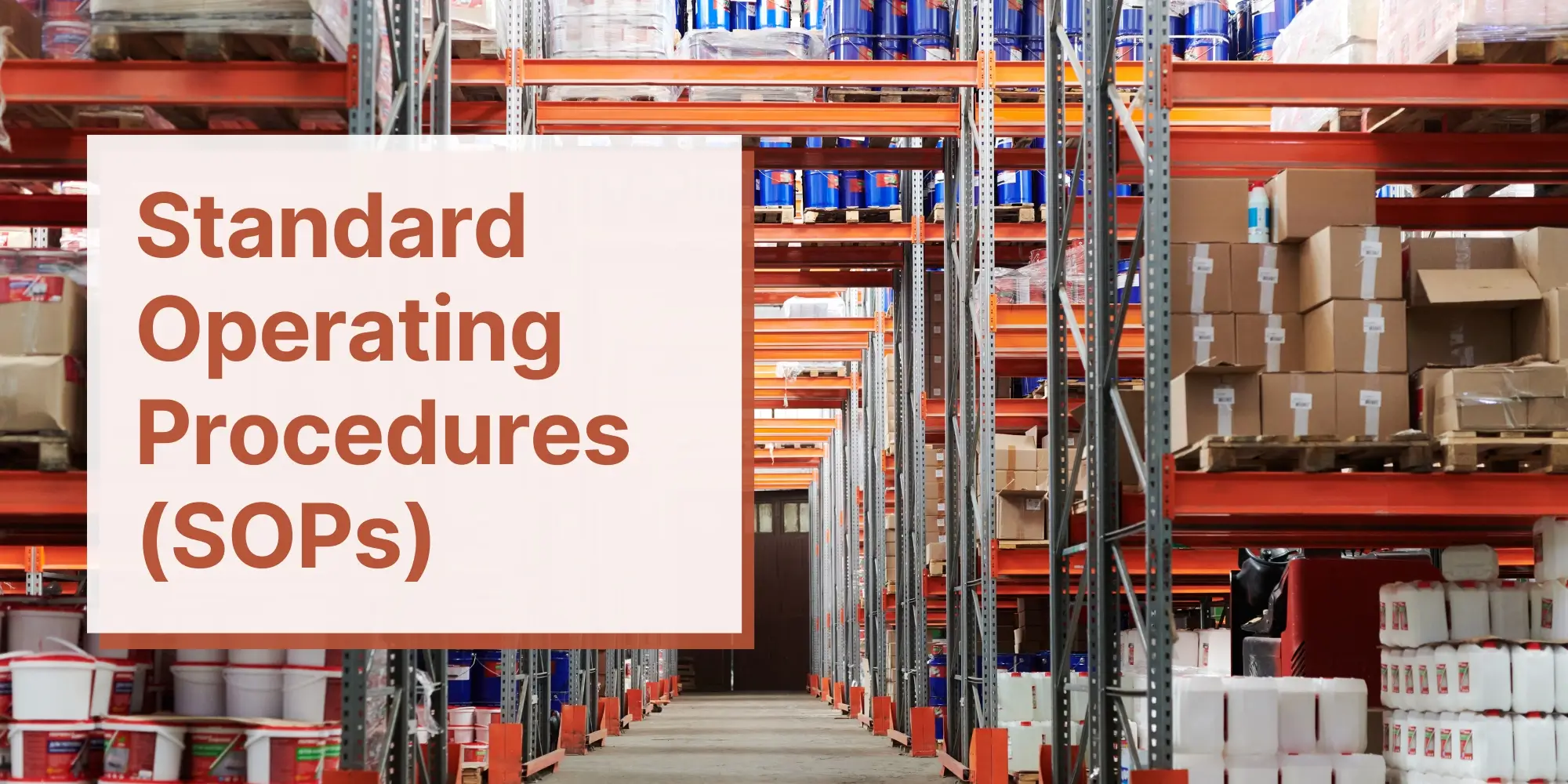
Standard Operating Procedures (SOPs)
Standard Operating Procedures (SOPs) are essential documents that outline the step-by-step processes for performing specific tasks in a warehouse. By incorporating safety protocols and checklists, SOPs help ensure that every task is performed consistently and safely, reducing the risk of accidents and injuries. Well-developed SOPs are crucial for maintaining high safety standards and operational efficiency in any warehouse environment.
How to Develop SOPs That Incorporate Safety Protocols and Checklists
Creating effective SOPs requires careful planning and attention to detail. Here’s a step-by-step guide to developing SOPs that integrate safety protocols and checklists:
1. Identify Key Processes and Tasks:
- Start by identifying all the critical processes and tasks that occur in your warehouse. These might include tasks like forklift operation, material handling, equipment maintenance, emergency response, and more.
- Prioritize tasks that involve significant risks or have a history of incidents.
2. Engage with Subject Matter Experts:
- Collaborate with employees who are directly involved in the tasks to be documented. Their hands-on experience is invaluable for understanding the nuances of each process and identifying potential safety hazards.
- Involve safety officers or consultants to ensure that all safety aspects are thoroughly covered.
3. Outline the Steps for Each Task:
- Break down each task into clear, sequential steps. Ensure that the instructions are detailed enough for anyone to follow, regardless of their experience level.
- Include specific instructions on how to perform the task safely, such as proper lifting techniques, the use of personal protective equipment (PPE), or safe operating procedures for machinery.
4. Incorporate Safety Protocols:
- For each step in the SOP, integrate relevant safety protocols. This might include safety checks before starting a task, steps to take in case of an emergency, or precautions to avoid common hazards.
- Ensure that safety protocols are easy to understand and follow. Use clear language and avoid jargon that might confuse employees.
5. Embed Checklists:
- Incorporate checklists within the SOPs to ensure that safety procedures are consistently followed. For example, a forklift operation SOP might include a pre-operation checklist to verify that the equipment is in good working condition.
- Place checklists at critical points in the SOP where they naturally fit into the workflow. Ensure that these checklists are comprehensive but concise enough to be used effectively without slowing down operations.
6. Review and Test the SOPs:
- Once the SOPs are drafted, review them with employees and safety officers to ensure accuracy and completeness.
- Conduct a trial run of the SOPs to identify any potential issues or areas that need clarification. Make adjustments based on feedback from the trial.
7. Implement and Train:
- Roll out the SOPs to all relevant employees. Provide training sessions to ensure that everyone understands the procedures and the importance of following them.
- Make the SOPs easily accessible, either in printed form or digitally, so that employees can refer to them as needed.
8. Continuous Improvement:
- Regularly review and update SOPs to reflect any changes in processes, equipment, or safety regulations.
- Encourage employees to provide feedback on the SOPs and suggest improvements.
The Role of SOPs in Ensuring Consistent Safety Practices
SOPs play a vital role in ensuring that safety practices are consistently applied across all areas of warehouse operations. Here’s how they contribute to a safer work environment:
- Standardization of Processes: SOPs provide a standardized approach to completing tasks, ensuring that everyone performs them in the same safe and efficient manner. This reduces variability in how tasks are done, which is a common source of accidents.
- Clear Communication: By clearly outlining each step of a task, SOPs eliminate ambiguity and misunderstandings that could lead to unsafe practices. Employees know exactly what is expected of them and how to perform their duties safely.
- Reinforcement of Safety Protocols: Integrating safety protocols directly into SOPs reinforces their importance and makes them an integral part of daily operations. Employees are continuously reminded of the safety measures they must follow, which helps embed these practices into the company culture.
- Training and Onboarding: SOPs are invaluable training tools, especially for new employees. They provide a clear guide for learning how to perform tasks safely and efficiently, reducing the learning curve and minimizing the risk of errors.
- Compliance and Accountability: SOPs help ensure compliance with regulatory requirements by documenting that safety protocols are in place and followed. They also provide a basis for accountability, as employees can be held responsible for following the procedures outlined in the SOPs.
- Continuous Safety Monitoring: SOPs that include checklists allow for ongoing safety monitoring. By regularly completing checklists, employees can identify and report hazards, leading to prompt corrective actions and continuous improvement of safety practices.
In conclusion, well-developed SOPs are essential for maintaining consistent safety practices in a warehouse. They provide clear, standardized instructions that integrate safety protocols and checklists, ensuring that every task is performed safely and efficiently. By using SOPs, warehouses can minimize risks, comply with safety regulations, and foster a culture of safety that protects both employees and the business.
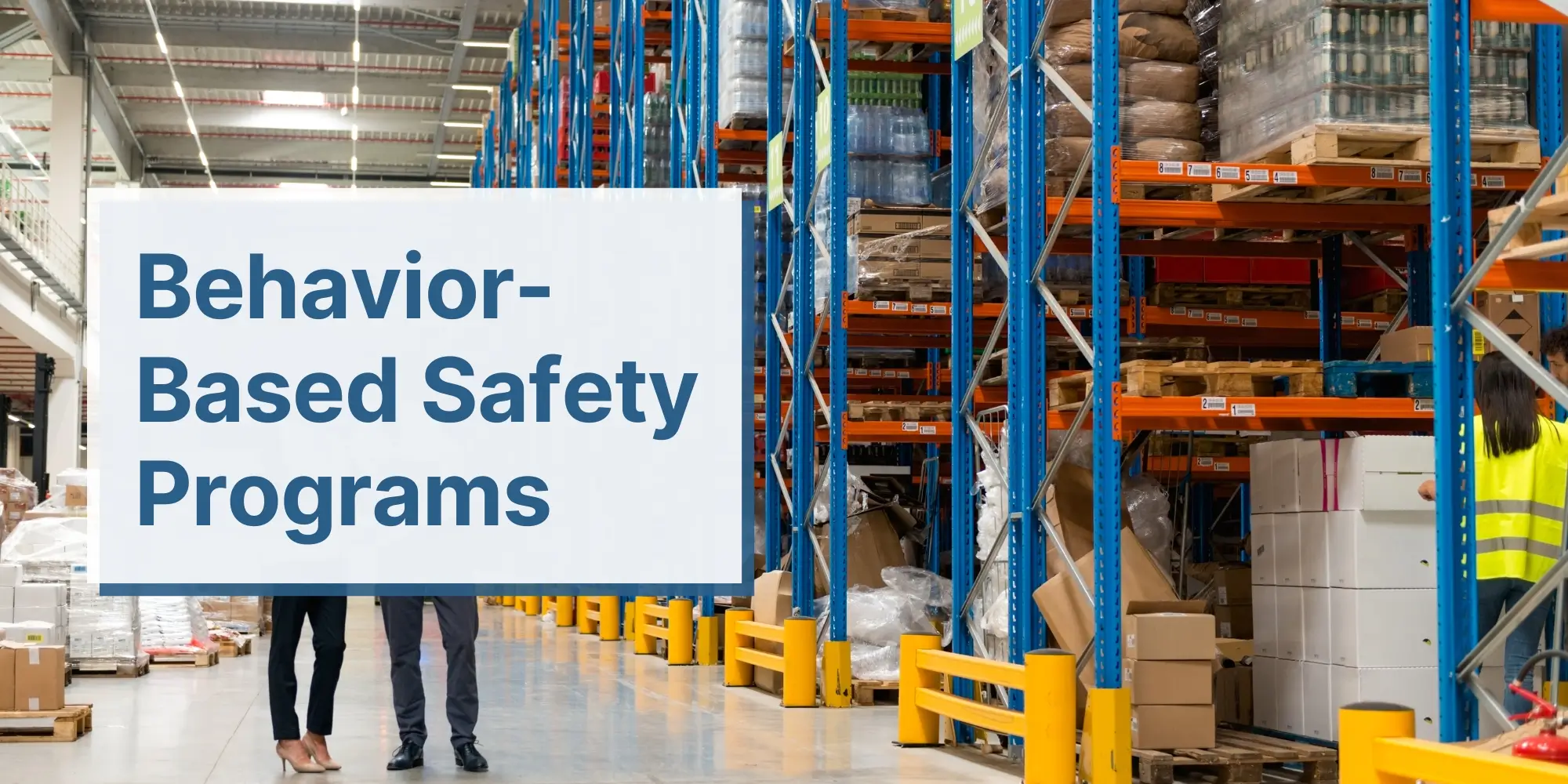
Behavior-Based Safety Programs
Behavior-based safety (BBS) programs are an increasingly popular approach to improving safety outcomes in the workplace, particularly in environments like warehouses, where risks are high and the potential for accidents is significant. Unlike traditional safety programs that focus primarily on compliance and procedures, behavior-based safety programs emphasize the role of individual behaviors and attitudes in creating a safer work environment. By targeting the root causes of unsafe actions, BBS programs seek to foster a proactive safety culture where everyone is engaged in identifying and mitigating risks.
Introduction to Behavior-Based Safety Programs
Behavior-based safety programs are built on the understanding that most workplace accidents are caused by unsafe behaviors rather than unsafe conditions alone. These programs aim to identify, observe, and modify unsafe behaviors through a structured process that encourages continuous improvement. The core principles of BBS programs include:
- Observation: Trained observers, often fellow employees or supervisors, watch for specific behaviors that could lead to accidents. These observations are typically non-punitive and are intended to gather data on how work is actually being performed.
- Feedback: After observing, feedback is provided to the employee involved. This feedback is constructive, focusing on what was done correctly and what could be improved. The goal is to encourage safe behaviors and reduce or eliminate unsafe ones.
- Intervention: When unsafe behaviors are identified, interventions are implemented to change these behaviors. This might involve additional training, changes to procedures, or even redesigning the work environment to make it easier to perform tasks safely.
- Continuous Improvement: Behavior-based safety is not a one-time effort but an ongoing process. Regular observations, feedback sessions, and interventions help to continually improve safety behaviors and outcomes.
The ultimate aim of a BBS program is to create a safety-conscious workforce where safe behaviors are the norm, not the exception. By focusing on behavior, BBS programs address the human factors that contribute to accidents, making them an effective complement to traditional safety measures.
Collaboration Between Employers and Employees
For a behavior-based safety program to be successful, there must be strong collaboration between employers and employees. This partnership is crucial for building trust, ensuring buy-in, and fostering a positive safety culture.
- Employer Commitment: Employers play a critical role in establishing and maintaining a behavior-based safety program. This includes providing the necessary resources, training, and support for the program. Employers must demonstrate their commitment to safety by actively participating in the program, addressing issues that are identified, and rewarding positive safety behaviors.
- Employee Involvement: Employees are at the heart of any BBS program. Their participation is essential, as they are the ones performing the tasks and engaging in the behaviors being observed. Employees should be encouraged to take an active role in the program, whether by serving as observers, providing feedback to their peers, or suggesting improvements to safety practices.
- Open Communication: Successful BBS programs rely on open and transparent communication between all levels of the organization. Employees need to feel comfortable discussing safety concerns, reporting unsafe behaviors, and giving and receiving feedback. Employers should create an environment where communication about safety is encouraged and valued.
- Positive Reinforcement: Behavior-based safety programs emphasize positive reinforcement rather than punishment. When employees engage in safe behaviors, they should be recognized and rewarded. This positive reinforcement helps to build a safety culture where safe practices are consistently followed and celebrated.
- Continuous Learning: Both employers and employees should view BBS programs as opportunities for continuous learning. By regularly reviewing observations and feedback, the organization can identify trends, adapt to new challenges, and continuously improve safety practices.
Fostering a Positive Safety Culture
Behavior-based safety programs are most effective when they are part of a broader effort to foster a positive safety culture within the organization. A positive safety culture is one where safety is prioritized at every level, and everyone feels responsible for maintaining a safe work environment.
- Leadership Support: Leaders in the organization must set the tone for the safety culture. Their actions and attitudes towards safety will influence how employees view the importance of safe behaviors. Leaders should model the behaviors they expect from their employees and actively support the BBS program.
- Employee Empowerment: Empowering employees to take ownership of safety is key to a positive safety culture. Employees should feel that they have the authority to stop work if they identify a hazard, suggest improvements to safety procedures, and participate in safety initiatives.
- Integration with Other Safety Programs: Behavior-based safety should not operate in isolation but should be integrated with other safety programs and initiatives. This integration ensures that all aspects of safety are addressed, from equipment maintenance to emergency preparedness.
- Regular Reinforcement: A positive safety culture requires regular reinforcement. This can be achieved through ongoing training, safety meetings, and recognition of safe behaviors. Reinforcement helps to keep safety top-of-mind and ensures that the culture remains strong over time.
In conclusion, behavior-based safety programs offer a powerful approach to improving safety outcomes in warehouses and other high-risk environments. By focusing on the behaviors that lead to accidents, these programs help to create a proactive, engaged, and safety-conscious workforce. Collaboration between employers and employees is essential to the success of BBS programs, and when combined with a strong safety culture, they can lead to significant reductions in workplace accidents and injuries.

Creating a Positive Safety Culture
A positive safety culture is the foundation of a safe and productive workplace. It goes beyond merely following safety rules and regulations; it involves embedding safety into every aspect of the workplace environment, making it a core value that guides all actions and decisions. Creating such a culture requires deliberate strategies and a commitment from all levels of the organization, particularly leadership.
Strategies for Embedding Safety into the Workplace Culture
1. Lead by Example:
Leadership must consistently demonstrate a commitment to safety. When leaders prioritize safety in their own actions—by following safety protocols, wearing appropriate PPE, and addressing hazards promptly—they set a powerful example for the rest of the organization. This behavior reinforces the importance of safety and encourages employees to adopt the same mindset.
2. Integrate Safety into Daily Operations:
Safety should be woven into the fabric of daily work routines. This includes incorporating safety discussions into regular meetings, starting each shift with a safety briefing, and ensuring that safety checklists are a standard part of every task. By making safety an integral part of daily operations, it becomes a natural consideration in every activity.
3. Empower Employees to Take Ownership of Safety:
Employees should feel empowered to take responsibility for their own safety and the safety of their colleagues. This can be achieved by providing training that emphasizes the importance of personal accountability and encouraging employees to speak up when they see unsafe practices. Empowerment also involves giving workers the authority to halt operations if they identify a serious safety hazard.
4. Recognize and Reward Safe Behavior:
Positive reinforcement is a powerful tool for promoting a safety culture. Recognizing and rewarding employees who consistently follow safety protocols or take proactive steps to improve safety can motivate others to do the same. This recognition can take many forms, such as verbal praise, safety awards, or even incentives like bonuses or extra time off.
5. Continuous Safety Education and Training:
Ongoing education and training are critical for maintaining a strong safety culture. Regular training sessions, safety drills, and workshops help keep safety knowledge fresh and relevant. It also provides an opportunity to update employees on new safety practices, equipment, or regulations. Continuous learning reinforces the message that safety is an ongoing priority.
6. Engage Employees in Safety Initiatives:
Involve employees in the development and implementation of safety programs and initiatives. This engagement not only provides valuable insights from those on the front lines but also fosters a sense of ownership and commitment to safety. Employees are more likely to adhere to safety protocols that they helped create.
7. Promote Open Communication About Safety:
Open communication is essential for identifying and addressing safety issues before they lead to accidents. Encourage employees to report hazards, near-misses, and unsafe conditions without fear of retaliation. Establishing clear channels for reporting, such as anonymous suggestion boxes or digital platforms, can facilitate this communication.
The Role of Leadership in Promoting Safety
Leadership plays a crucial role in fostering a positive safety culture. Leaders set the tone for the entire organization and their actions and attitudes towards safety have a significant impact on employee behavior.
1. Visible Commitment:
Leaders must visibly demonstrate their commitment to safety. This can be done by regularly participating in safety meetings, conducting safety walk-throughs, and ensuring that safety is a key agenda item in strategic discussions. When employees see that leaders are genuinely invested in safety, they are more likely to follow suit.
2. Resource Allocation:
Leadership must allocate adequate resources to safety initiatives. This includes investing in proper safety equipment, providing comprehensive training programs, and ensuring that sufficient time is dedicated to safety activities. By prioritizing resources for safety, leaders show that they value their employees’ well-being.
3. Setting Clear Expectations:
Leaders should set clear expectations for safety performance. This includes defining specific safety goals, establishing metrics for measuring safety outcomes, and holding everyone in the organization accountable for meeting these standards. Clear expectations help align the entire workforce around a common goal of safety excellence.
4. Encouraging Worker Participation:
Leaders should encourage and facilitate worker participation in safety programs. This can be done by involving employees in safety committees, soliciting their input on safety policies, and encouraging them to take leadership roles in safety initiatives. Worker participation fosters a sense of ownership and engagement in safety efforts.
The Importance of Communication and Worker Well-Being
Effective communication and a focus on worker well-being are essential components of a positive safety culture.
1. Transparent and Frequent Communication:
Open and transparent communication about safety ensures that everyone is aware of the risks, the measures in place to mitigate those risks, and their role in maintaining a safe environment. Regular updates on safety performance, new initiatives, and lessons learned from incidents help keep safety top-of-mind.
2. Addressing Worker Concerns:
Listening to and addressing worker concerns is critical for building trust and ensuring that safety measures are effective. Workers should feel comfortable voicing their concerns, knowing that leadership will take them seriously and act on them. Addressing concerns promptly and effectively demonstrates that the organization values its employees’ safety and well-being.
3. Focusing on Worker Well-Being:
A positive safety culture is closely linked to overall worker well-being. Organizations should promote not just physical safety but also mental and emotional well-being. This includes providing support for stress management, ensuring reasonable workloads, and fostering a work-life balance. When workers feel cared for, they are more likely to be engaged and committed to maintaining a safe workplace.
In conclusion, creating a positive safety culture requires a comprehensive approach that involves embedding safety into every aspect of the workplace, from daily operations to leadership actions. By prioritizing safety, empowering employees, and fostering open communication, organizations can build a culture where safety is not just a priority but a shared value that drives every decision and action.
Conclusion
Creating a safe warehouse environment is not just a regulatory requirement—it’s a fundamental responsibility that protects the well-being of workers and ensures the smooth operation of the business. A safe workplace fosters a culture of trust, productivity, and resilience, where employees feel valued and are motivated to perform at their best.
By implementing comprehensive safety measures, including behavior-based safety programs, well-developed Standard Operating Procedures (SOPs), and regular safety training, businesses can significantly reduce the risk of accidents and injuries. The use of safety checklists, continuous safety audits, and the active involvement of both leadership and employees are crucial in maintaining high safety standards and adapting to the dynamic challenges of warehouse operations.
A well-maintained safety program offers numerous benefits beyond protecting workers. It leads to increased operational efficiency, reduced downtime, and lower costs associated with workplace accidents. Moreover, it enhances the company’s reputation, attracting both talent and customers who value a commitment to safety. Ultimately, a strong safety culture is a key driver of long-term success, ensuring that the warehouse remains a safe, productive, and positive environment for everyone involved.
In conclusion, investing in warehouse safety is not just about compliance; it’s about building a foundation for a thriving business. By prioritizing safety, businesses can protect their most valuable asset—their people—while also reaping the rewards of a safer, more efficient, and more successful operation.

